Crim 101: Term Paper on Sexual Orientation Discrimination in Canada
VerifiedAdded on 2022/10/08
|8
|1815
|13
Report
AI Summary
This term paper delves into the issue of sexual orientation discrimination in Canada, examining its legal history, current manifestations, and societal impacts. The paper begins with an introduction that defines sexual orientation and highlights Canada's legal advancements in the area, while also acknowledging persistent discrimination. It provides an overview of the historical context, including the legal recognition of same-sex sexual activities and the evolution of human rights protections. The paper then explores specific instances of discrimination, including workplace issues, such as the case of a lesbian couple forced to leave their jobs. It references relevant legislation like the Canadian Charter of Rights and Freedoms, the Canadian Human Rights Act, and the Criminal Code, as well as the Ontario Human Rights Code. Furthermore, the paper incorporates findings from academic research, including studies on earning disparities and the impact of workplace support on transgender employees. The conclusion summarizes the key points, emphasizing that despite legal progress, discrimination based on sexual orientation persists in Canada.
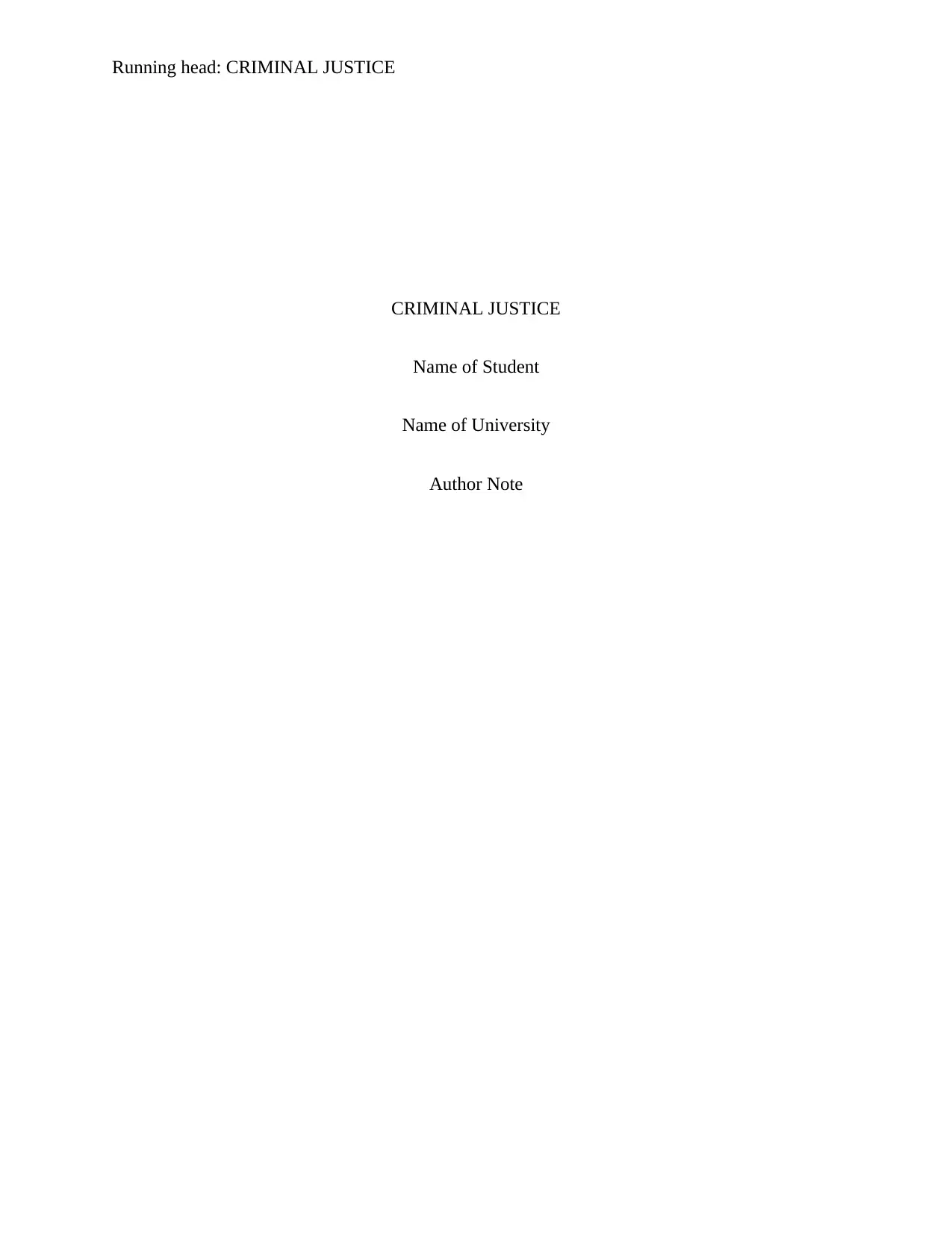
Running head: CRIMINAL JUSTICE
CRIMINAL JUSTICE
Name of Student
Name of University
Author Note
CRIMINAL JUSTICE
Name of Student
Name of University
Author Note
Paraphrase This Document
Need a fresh take? Get an instant paraphrase of this document with our AI Paraphraser
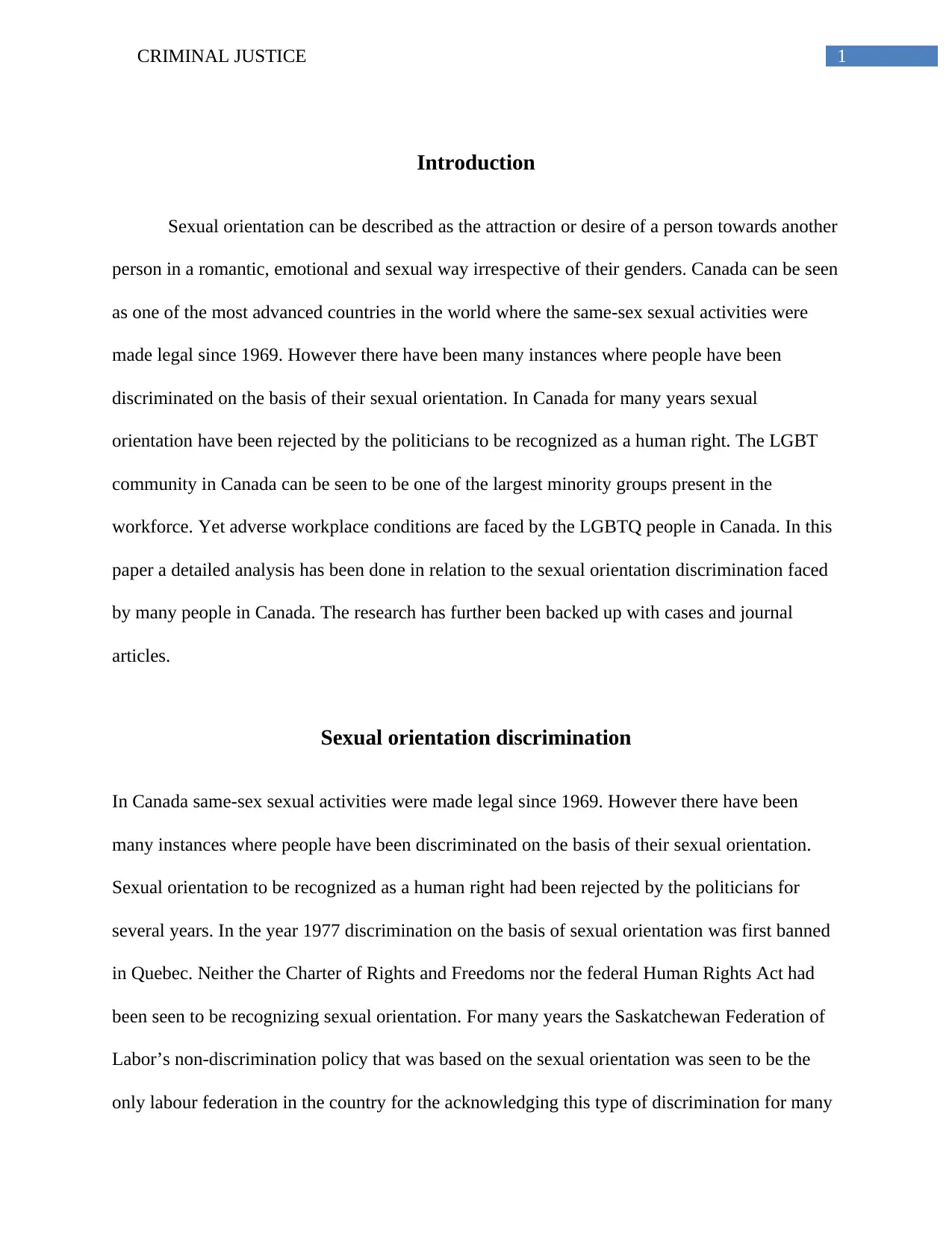
1CRIMINAL JUSTICE
Introduction
Sexual orientation can be described as the attraction or desire of a person towards another
person in a romantic, emotional and sexual way irrespective of their genders. Canada can be seen
as one of the most advanced countries in the world where the same-sex sexual activities were
made legal since 1969. However there have been many instances where people have been
discriminated on the basis of their sexual orientation. In Canada for many years sexual
orientation have been rejected by the politicians to be recognized as a human right. The LGBT
community in Canada can be seen to be one of the largest minority groups present in the
workforce. Yet adverse workplace conditions are faced by the LGBTQ people in Canada. In this
paper a detailed analysis has been done in relation to the sexual orientation discrimination faced
by many people in Canada. The research has further been backed up with cases and journal
articles.
Sexual orientation discrimination
In Canada same-sex sexual activities were made legal since 1969. However there have been
many instances where people have been discriminated on the basis of their sexual orientation.
Sexual orientation to be recognized as a human right had been rejected by the politicians for
several years. In the year 1977 discrimination on the basis of sexual orientation was first banned
in Quebec. Neither the Charter of Rights and Freedoms nor the federal Human Rights Act had
been seen to be recognizing sexual orientation. For many years the Saskatchewan Federation of
Labor’s non-discrimination policy that was based on the sexual orientation was seen to be the
only labour federation in the country for the acknowledging this type of discrimination for many
Introduction
Sexual orientation can be described as the attraction or desire of a person towards another
person in a romantic, emotional and sexual way irrespective of their genders. Canada can be seen
as one of the most advanced countries in the world where the same-sex sexual activities were
made legal since 1969. However there have been many instances where people have been
discriminated on the basis of their sexual orientation. In Canada for many years sexual
orientation have been rejected by the politicians to be recognized as a human right. The LGBT
community in Canada can be seen to be one of the largest minority groups present in the
workforce. Yet adverse workplace conditions are faced by the LGBTQ people in Canada. In this
paper a detailed analysis has been done in relation to the sexual orientation discrimination faced
by many people in Canada. The research has further been backed up with cases and journal
articles.
Sexual orientation discrimination
In Canada same-sex sexual activities were made legal since 1969. However there have been
many instances where people have been discriminated on the basis of their sexual orientation.
Sexual orientation to be recognized as a human right had been rejected by the politicians for
several years. In the year 1977 discrimination on the basis of sexual orientation was first banned
in Quebec. Neither the Charter of Rights and Freedoms nor the federal Human Rights Act had
been seen to be recognizing sexual orientation. For many years the Saskatchewan Federation of
Labor’s non-discrimination policy that was based on the sexual orientation was seen to be the
only labour federation in the country for the acknowledging this type of discrimination for many
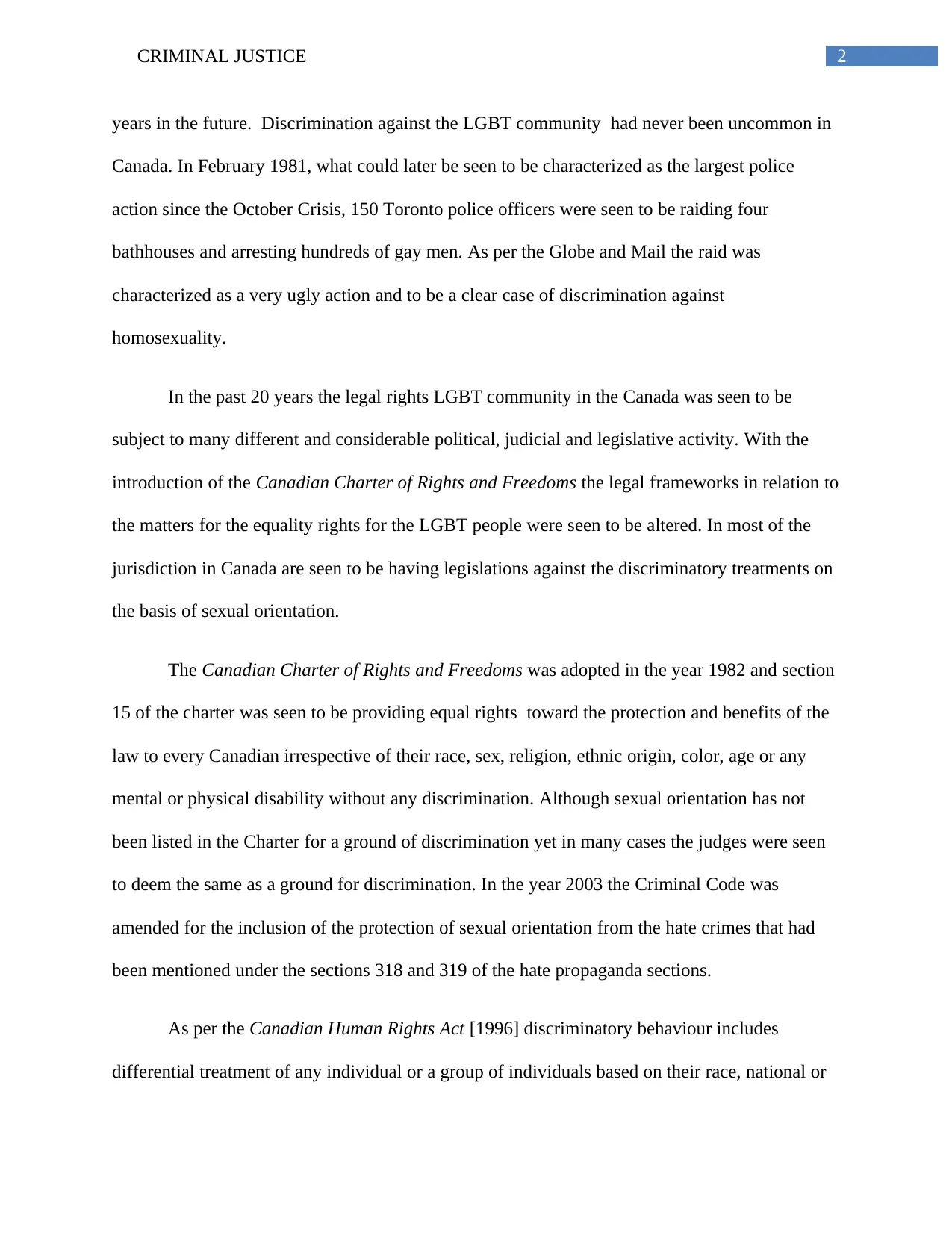
2CRIMINAL JUSTICE
years in the future. Discrimination against the LGBT community had never been uncommon in
Canada. In February 1981, what could later be seen to be characterized as the largest police
action since the October Crisis, 150 Toronto police officers were seen to be raiding four
bathhouses and arresting hundreds of gay men. As per the Globe and Mail the raid was
characterized as a very ugly action and to be a clear case of discrimination against
homosexuality.
In the past 20 years the legal rights LGBT community in the Canada was seen to be
subject to many different and considerable political, judicial and legislative activity. With the
introduction of the Canadian Charter of Rights and Freedoms the legal frameworks in relation to
the matters for the equality rights for the LGBT people were seen to be altered. In most of the
jurisdiction in Canada are seen to be having legislations against the discriminatory treatments on
the basis of sexual orientation.
The Canadian Charter of Rights and Freedoms was adopted in the year 1982 and section
15 of the charter was seen to be providing equal rights toward the protection and benefits of the
law to every Canadian irrespective of their race, sex, religion, ethnic origin, color, age or any
mental or physical disability without any discrimination. Although sexual orientation has not
been listed in the Charter for a ground of discrimination yet in many cases the judges were seen
to deem the same as a ground for discrimination. In the year 2003 the Criminal Code was
amended for the inclusion of the protection of sexual orientation from the hate crimes that had
been mentioned under the sections 318 and 319 of the hate propaganda sections.
As per the Canadian Human Rights Act [1996] discriminatory behaviour includes
differential treatment of any individual or a group of individuals based on their race, national or
years in the future. Discrimination against the LGBT community had never been uncommon in
Canada. In February 1981, what could later be seen to be characterized as the largest police
action since the October Crisis, 150 Toronto police officers were seen to be raiding four
bathhouses and arresting hundreds of gay men. As per the Globe and Mail the raid was
characterized as a very ugly action and to be a clear case of discrimination against
homosexuality.
In the past 20 years the legal rights LGBT community in the Canada was seen to be
subject to many different and considerable political, judicial and legislative activity. With the
introduction of the Canadian Charter of Rights and Freedoms the legal frameworks in relation to
the matters for the equality rights for the LGBT people were seen to be altered. In most of the
jurisdiction in Canada are seen to be having legislations against the discriminatory treatments on
the basis of sexual orientation.
The Canadian Charter of Rights and Freedoms was adopted in the year 1982 and section
15 of the charter was seen to be providing equal rights toward the protection and benefits of the
law to every Canadian irrespective of their race, sex, religion, ethnic origin, color, age or any
mental or physical disability without any discrimination. Although sexual orientation has not
been listed in the Charter for a ground of discrimination yet in many cases the judges were seen
to deem the same as a ground for discrimination. In the year 2003 the Criminal Code was
amended for the inclusion of the protection of sexual orientation from the hate crimes that had
been mentioned under the sections 318 and 319 of the hate propaganda sections.
As per the Canadian Human Rights Act [1996] discriminatory behaviour includes
differential treatment of any individual or a group of individuals based on their race, national or
⊘ This is a preview!⊘
Do you want full access?
Subscribe today to unlock all pages.

Trusted by 1+ million students worldwide
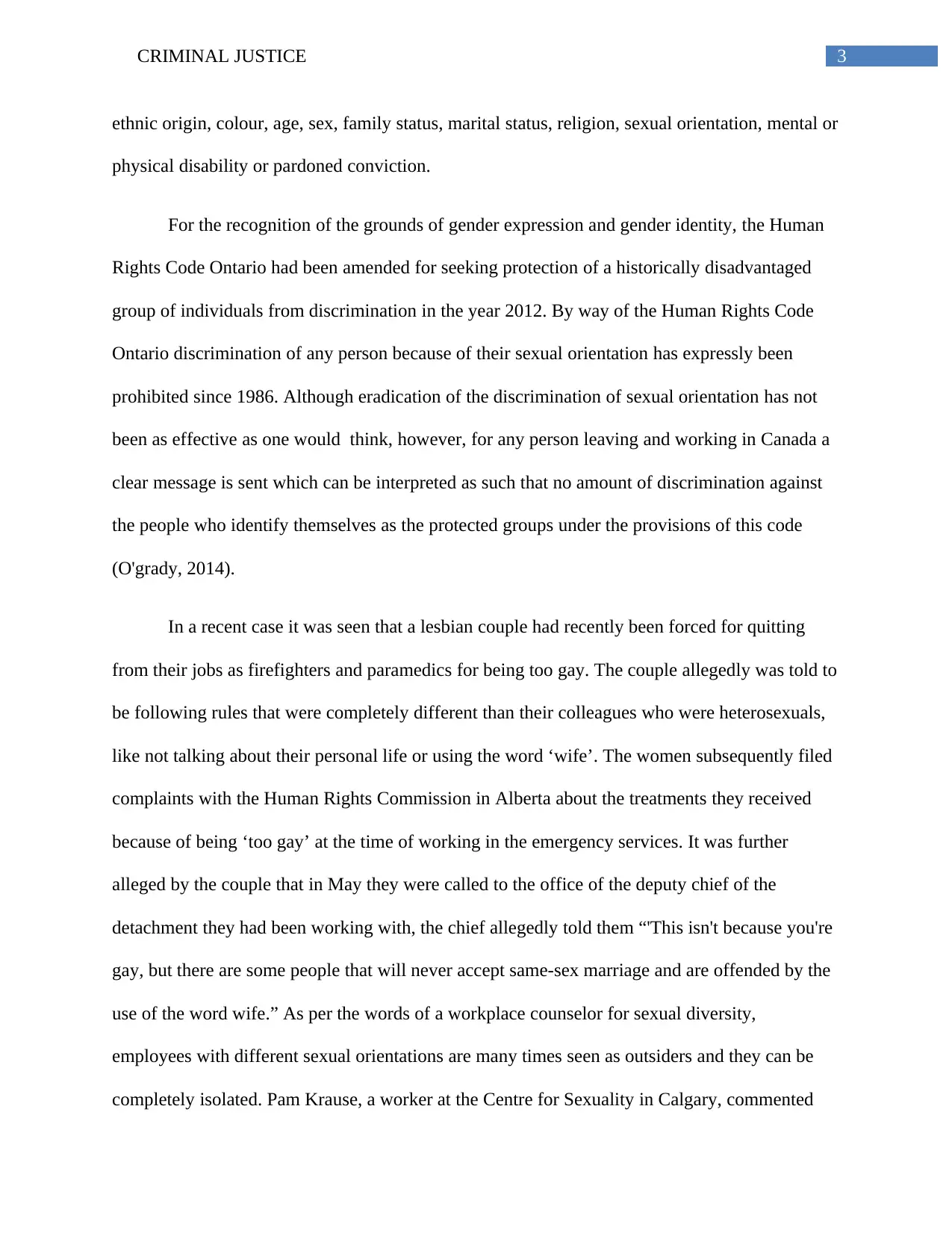
3CRIMINAL JUSTICE
ethnic origin, colour, age, sex, family status, marital status, religion, sexual orientation, mental or
physical disability or pardoned conviction.
For the recognition of the grounds of gender expression and gender identity, the Human
Rights Code Ontario had been amended for seeking protection of a historically disadvantaged
group of individuals from discrimination in the year 2012. By way of the Human Rights Code
Ontario discrimination of any person because of their sexual orientation has expressly been
prohibited since 1986. Although eradication of the discrimination of sexual orientation has not
been as effective as one would think, however, for any person leaving and working in Canada a
clear message is sent which can be interpreted as such that no amount of discrimination against
the people who identify themselves as the protected groups under the provisions of this code
(O'grady, 2014).
In a recent case it was seen that a lesbian couple had recently been forced for quitting
from their jobs as firefighters and paramedics for being too gay. The couple allegedly was told to
be following rules that were completely different than their colleagues who were heterosexuals,
like not talking about their personal life or using the word ‘wife’. The women subsequently filed
complaints with the Human Rights Commission in Alberta about the treatments they received
because of being ‘too gay’ at the time of working in the emergency services. It was further
alleged by the couple that in May they were called to the office of the deputy chief of the
detachment they had been working with, the chief allegedly told them “'This isn't because you're
gay, but there are some people that will never accept same-sex marriage and are offended by the
use of the word wife.” As per the words of a workplace counselor for sexual diversity,
employees with different sexual orientations are many times seen as outsiders and they can be
completely isolated. Pam Krause, a worker at the Centre for Sexuality in Calgary, commented
ethnic origin, colour, age, sex, family status, marital status, religion, sexual orientation, mental or
physical disability or pardoned conviction.
For the recognition of the grounds of gender expression and gender identity, the Human
Rights Code Ontario had been amended for seeking protection of a historically disadvantaged
group of individuals from discrimination in the year 2012. By way of the Human Rights Code
Ontario discrimination of any person because of their sexual orientation has expressly been
prohibited since 1986. Although eradication of the discrimination of sexual orientation has not
been as effective as one would think, however, for any person leaving and working in Canada a
clear message is sent which can be interpreted as such that no amount of discrimination against
the people who identify themselves as the protected groups under the provisions of this code
(O'grady, 2014).
In a recent case it was seen that a lesbian couple had recently been forced for quitting
from their jobs as firefighters and paramedics for being too gay. The couple allegedly was told to
be following rules that were completely different than their colleagues who were heterosexuals,
like not talking about their personal life or using the word ‘wife’. The women subsequently filed
complaints with the Human Rights Commission in Alberta about the treatments they received
because of being ‘too gay’ at the time of working in the emergency services. It was further
alleged by the couple that in May they were called to the office of the deputy chief of the
detachment they had been working with, the chief allegedly told them “'This isn't because you're
gay, but there are some people that will never accept same-sex marriage and are offended by the
use of the word wife.” As per the words of a workplace counselor for sexual diversity,
employees with different sexual orientations are many times seen as outsiders and they can be
completely isolated. Pam Krause, a worker at the Centre for Sexuality in Calgary, commented
Paraphrase This Document
Need a fresh take? Get an instant paraphrase of this document with our AI Paraphraser
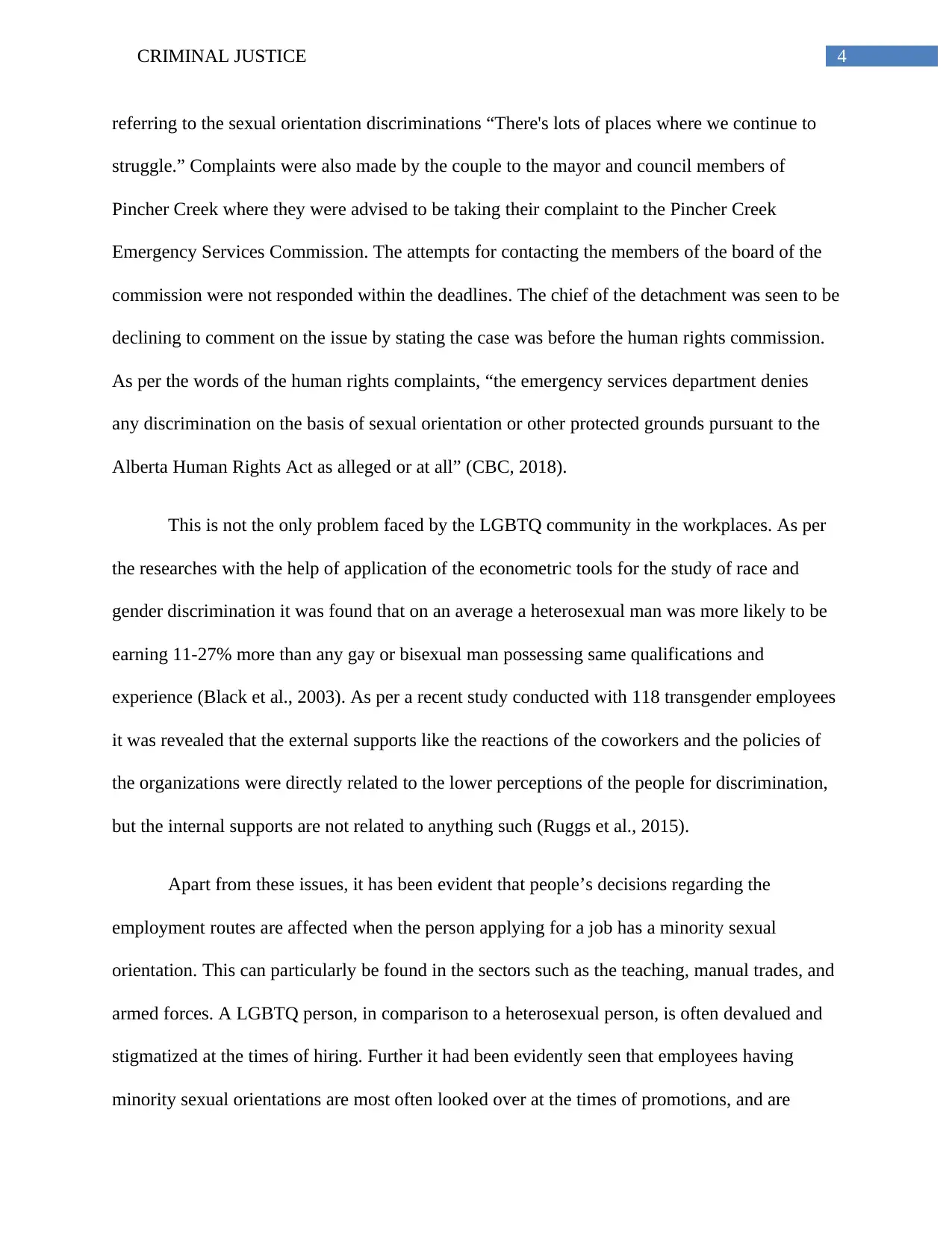
4CRIMINAL JUSTICE
referring to the sexual orientation discriminations “There's lots of places where we continue to
struggle.” Complaints were also made by the couple to the mayor and council members of
Pincher Creek where they were advised to be taking their complaint to the Pincher Creek
Emergency Services Commission. The attempts for contacting the members of the board of the
commission were not responded within the deadlines. The chief of the detachment was seen to be
declining to comment on the issue by stating the case was before the human rights commission.
As per the words of the human rights complaints, “the emergency services department denies
any discrimination on the basis of sexual orientation or other protected grounds pursuant to the
Alberta Human Rights Act as alleged or at all” (CBC, 2018).
This is not the only problem faced by the LGBTQ community in the workplaces. As per
the researches with the help of application of the econometric tools for the study of race and
gender discrimination it was found that on an average a heterosexual man was more likely to be
earning 11-27% more than any gay or bisexual man possessing same qualifications and
experience (Black et al., 2003). As per a recent study conducted with 118 transgender employees
it was revealed that the external supports like the reactions of the coworkers and the policies of
the organizations were directly related to the lower perceptions of the people for discrimination,
but the internal supports are not related to anything such (Ruggs et al., 2015).
Apart from these issues, it has been evident that people’s decisions regarding the
employment routes are affected when the person applying for a job has a minority sexual
orientation. This can particularly be found in the sectors such as the teaching, manual trades, and
armed forces. A LGBTQ person, in comparison to a heterosexual person, is often devalued and
stigmatized at the times of hiring. Further it had been evidently seen that employees having
minority sexual orientations are most often looked over at the times of promotions, and are
referring to the sexual orientation discriminations “There's lots of places where we continue to
struggle.” Complaints were also made by the couple to the mayor and council members of
Pincher Creek where they were advised to be taking their complaint to the Pincher Creek
Emergency Services Commission. The attempts for contacting the members of the board of the
commission were not responded within the deadlines. The chief of the detachment was seen to be
declining to comment on the issue by stating the case was before the human rights commission.
As per the words of the human rights complaints, “the emergency services department denies
any discrimination on the basis of sexual orientation or other protected grounds pursuant to the
Alberta Human Rights Act as alleged or at all” (CBC, 2018).
This is not the only problem faced by the LGBTQ community in the workplaces. As per
the researches with the help of application of the econometric tools for the study of race and
gender discrimination it was found that on an average a heterosexual man was more likely to be
earning 11-27% more than any gay or bisexual man possessing same qualifications and
experience (Black et al., 2003). As per a recent study conducted with 118 transgender employees
it was revealed that the external supports like the reactions of the coworkers and the policies of
the organizations were directly related to the lower perceptions of the people for discrimination,
but the internal supports are not related to anything such (Ruggs et al., 2015).
Apart from these issues, it has been evident that people’s decisions regarding the
employment routes are affected when the person applying for a job has a minority sexual
orientation. This can particularly be found in the sectors such as the teaching, manual trades, and
armed forces. A LGBTQ person, in comparison to a heterosexual person, is often devalued and
stigmatized at the times of hiring. Further it had been evidently seen that employees having
minority sexual orientations are most often looked over at the times of promotions, and are
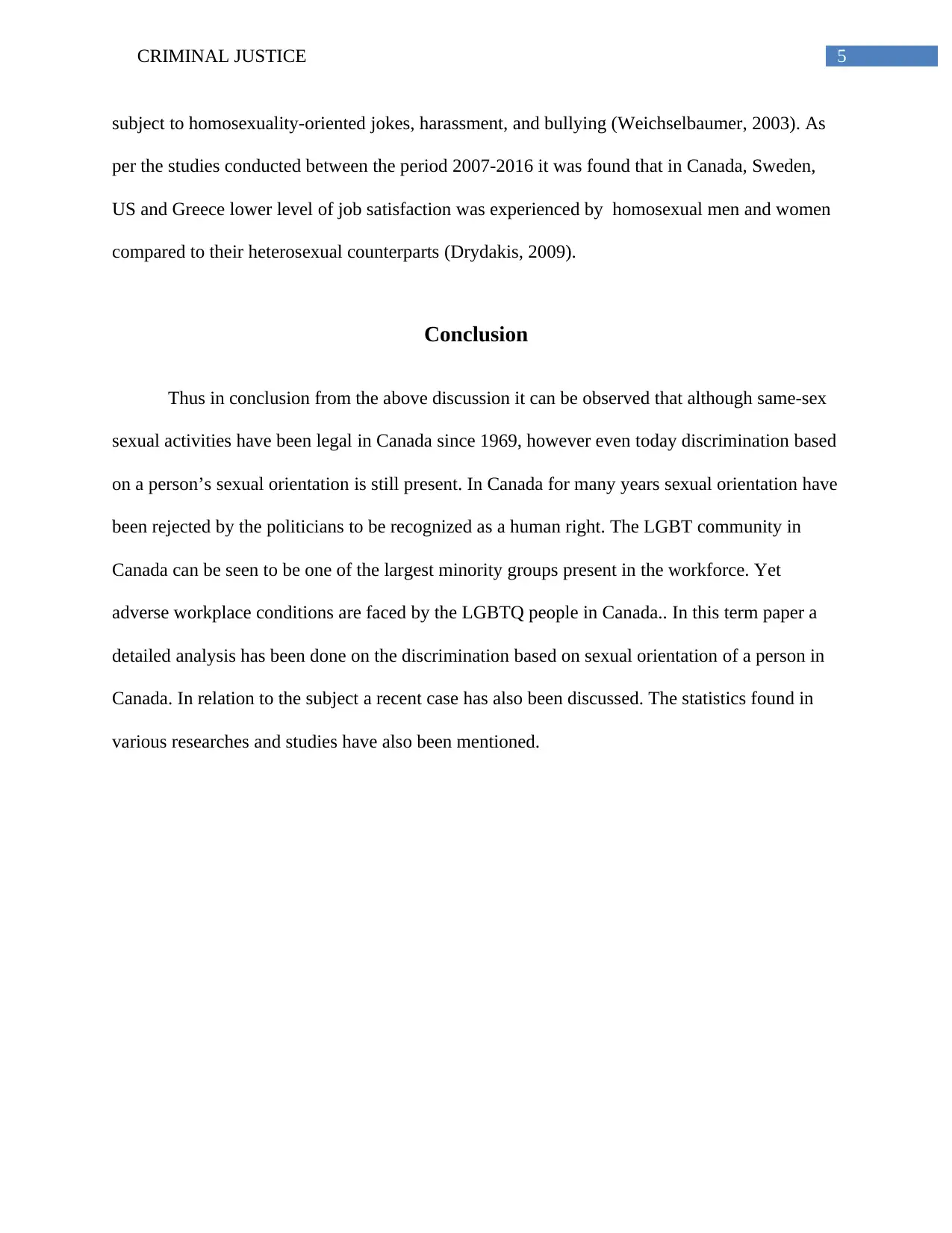
5CRIMINAL JUSTICE
subject to homosexuality-oriented jokes, harassment, and bullying (Weichselbaumer, 2003). As
per the studies conducted between the period 2007-2016 it was found that in Canada, Sweden,
US and Greece lower level of job satisfaction was experienced by homosexual men and women
compared to their heterosexual counterparts (Drydakis, 2009).
Conclusion
Thus in conclusion from the above discussion it can be observed that although same-sex
sexual activities have been legal in Canada since 1969, however even today discrimination based
on a person’s sexual orientation is still present. In Canada for many years sexual orientation have
been rejected by the politicians to be recognized as a human right. The LGBT community in
Canada can be seen to be one of the largest minority groups present in the workforce. Yet
adverse workplace conditions are faced by the LGBTQ people in Canada.. In this term paper a
detailed analysis has been done on the discrimination based on sexual orientation of a person in
Canada. In relation to the subject a recent case has also been discussed. The statistics found in
various researches and studies have also been mentioned.
subject to homosexuality-oriented jokes, harassment, and bullying (Weichselbaumer, 2003). As
per the studies conducted between the period 2007-2016 it was found that in Canada, Sweden,
US and Greece lower level of job satisfaction was experienced by homosexual men and women
compared to their heterosexual counterparts (Drydakis, 2009).
Conclusion
Thus in conclusion from the above discussion it can be observed that although same-sex
sexual activities have been legal in Canada since 1969, however even today discrimination based
on a person’s sexual orientation is still present. In Canada for many years sexual orientation have
been rejected by the politicians to be recognized as a human right. The LGBT community in
Canada can be seen to be one of the largest minority groups present in the workforce. Yet
adverse workplace conditions are faced by the LGBTQ people in Canada.. In this term paper a
detailed analysis has been done on the discrimination based on sexual orientation of a person in
Canada. In relation to the subject a recent case has also been discussed. The statistics found in
various researches and studies have also been mentioned.
⊘ This is a preview!⊘
Do you want full access?
Subscribe today to unlock all pages.

Trusted by 1+ million students worldwide
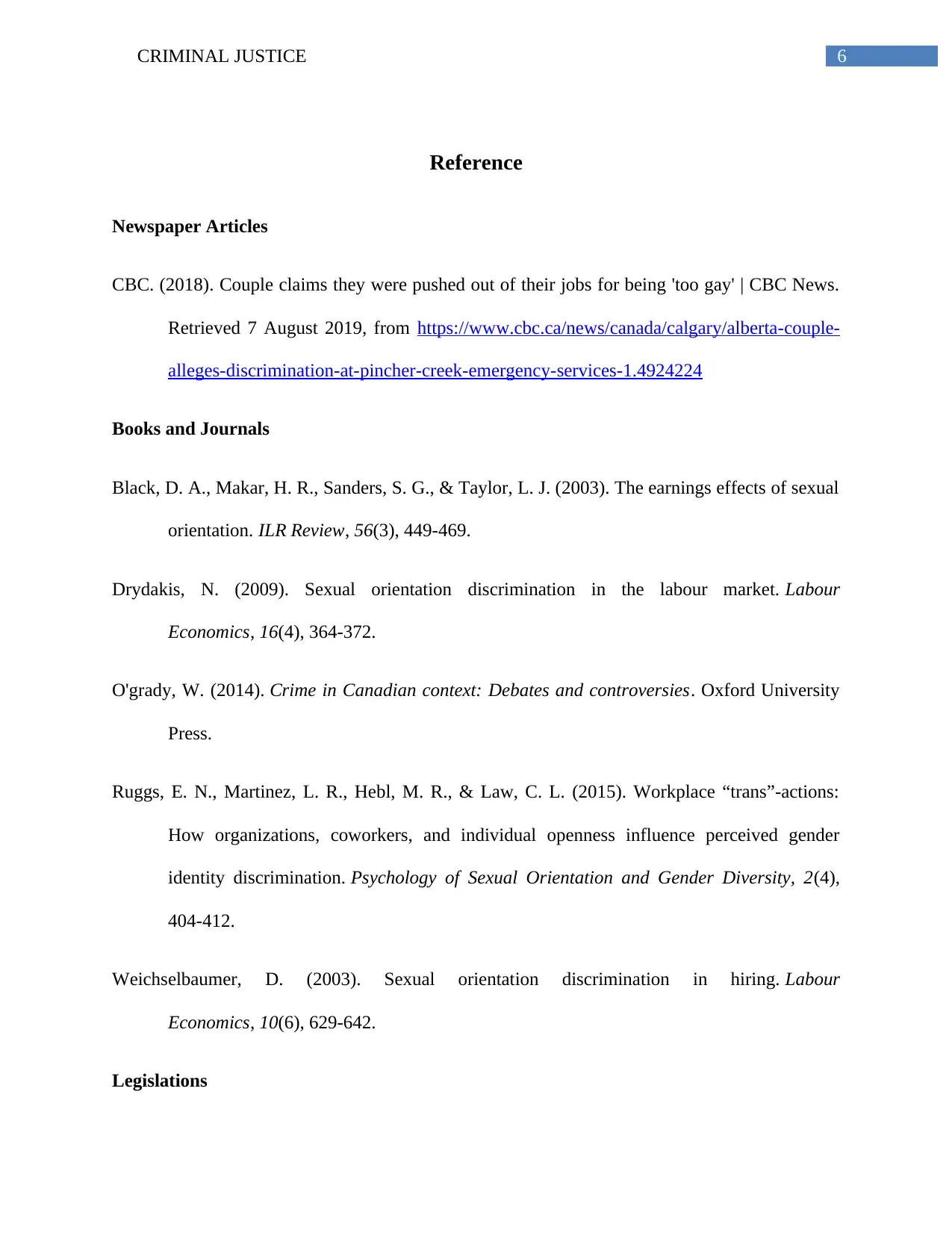
6CRIMINAL JUSTICE
Reference
Newspaper Articles
CBC. (2018). Couple claims they were pushed out of their jobs for being 'too gay' | CBC News.
Retrieved 7 August 2019, from https://www.cbc.ca/news/canada/calgary/alberta-couple-
alleges-discrimination-at-pincher-creek-emergency-services-1.4924224
Books and Journals
Black, D. A., Makar, H. R., Sanders, S. G., & Taylor, L. J. (2003). The earnings effects of sexual
orientation. ILR Review, 56(3), 449-469.
Drydakis, N. (2009). Sexual orientation discrimination in the labour market. Labour
Economics, 16(4), 364-372.
O'grady, W. (2014). Crime in Canadian context: Debates and controversies. Oxford University
Press.
Ruggs, E. N., Martinez, L. R., Hebl, M. R., & Law, C. L. (2015). Workplace “trans”-actions:
How organizations, coworkers, and individual openness influence perceived gender
identity discrimination. Psychology of Sexual Orientation and Gender Diversity, 2(4),
404-412.
Weichselbaumer, D. (2003). Sexual orientation discrimination in hiring. Labour
Economics, 10(6), 629-642.
Legislations
Reference
Newspaper Articles
CBC. (2018). Couple claims they were pushed out of their jobs for being 'too gay' | CBC News.
Retrieved 7 August 2019, from https://www.cbc.ca/news/canada/calgary/alberta-couple-
alleges-discrimination-at-pincher-creek-emergency-services-1.4924224
Books and Journals
Black, D. A., Makar, H. R., Sanders, S. G., & Taylor, L. J. (2003). The earnings effects of sexual
orientation. ILR Review, 56(3), 449-469.
Drydakis, N. (2009). Sexual orientation discrimination in the labour market. Labour
Economics, 16(4), 364-372.
O'grady, W. (2014). Crime in Canadian context: Debates and controversies. Oxford University
Press.
Ruggs, E. N., Martinez, L. R., Hebl, M. R., & Law, C. L. (2015). Workplace “trans”-actions:
How organizations, coworkers, and individual openness influence perceived gender
identity discrimination. Psychology of Sexual Orientation and Gender Diversity, 2(4),
404-412.
Weichselbaumer, D. (2003). Sexual orientation discrimination in hiring. Labour
Economics, 10(6), 629-642.
Legislations
Paraphrase This Document
Need a fresh take? Get an instant paraphrase of this document with our AI Paraphraser
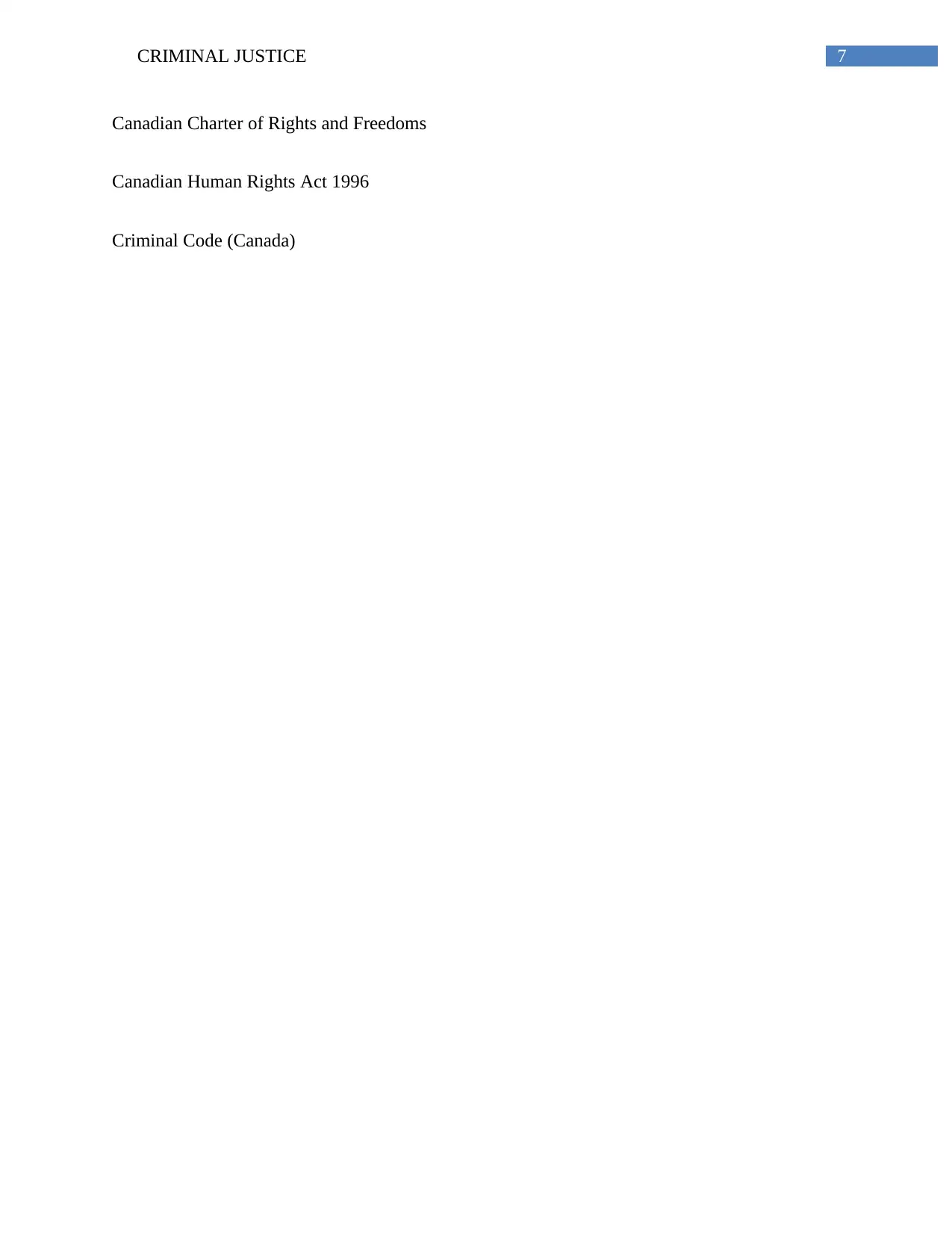
7CRIMINAL JUSTICE
Canadian Charter of Rights and Freedoms
Canadian Human Rights Act 1996
Criminal Code (Canada)
Canadian Charter of Rights and Freedoms
Canadian Human Rights Act 1996
Criminal Code (Canada)
1 out of 8
Related Documents
Your All-in-One AI-Powered Toolkit for Academic Success.
+13062052269
info@desklib.com
Available 24*7 on WhatsApp / Email
![[object Object]](/_next/static/media/star-bottom.7253800d.svg)
Unlock your academic potential
Copyright © 2020–2025 A2Z Services. All Rights Reserved. Developed and managed by ZUCOL.





